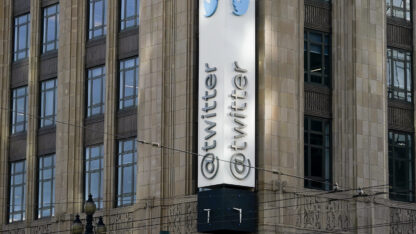Twitter owner Elon Musk says he’s pulling back the curtain on how the social network has handled high-profile content moderation decisions, including banning then-President Donald Trump after his supporters attacked the U.S. Capitol on Jan. 6, 2021.
Over the past two weeks, Musk has been releasing internal documents to a handpicked group of journalists who are digging through them and posting excerpts on Twitter.
Musk and his allies promote these tweet threads – dubbed the “Twitter Files” – as bombshell revelations proving that Twitter intentionally muzzled conservatives because of their political views. That’s a long-running claim by Republicans who are convinced social media companies censor them, despite ample evidence to the contrary. Twitter’s internal researchers, for example, have found its algorithms favor right-leaning political content.
But many tech journalists, social media experts and former Twitter employees say Musk’s claims are over-hyped, given that the documents shared so far largely corroborate what is already known about the messy business of policing a large social network.
“What is really coming through in the Twitter Files for me is: people who are confronting high-stakes, unanticipated events and trying to figure out what policies apply and how,” said Renée DiResta, research manager at the Stanford Internet Observatory, who studies how narratives spread on social networks.
What are the Twitter Files?
They’re a collection of internal emails and Slack chats capturing Twitter employees discussing company policies and fraught moderation calls. So far they’ve covered the decision to ban Trump, Twitter’s short-lived decision to block a news story in October 2020 drawn from material on Hunter Biden’s laptop, and how the company limits the reach of accounts that break its rules, including some well-known right-wing users.
Musk has given exclusive access to a small group of independent journalists including Matt Taibbi, formerly of Rolling Stone, and Bari Weiss, a former New York Times opinion columnist, under the condition they first post about the documents on Twitter.
The selection of Taibbi and Weiss, who both share Musk’s criticisms of the mainstream media and what they see as progressive censoriousness, has itself caused controversy. Other news outlets have not been given access to the original documents, which have been presented only in screenshots and excerpts in lengthy tweet threads, often without context.
What do the documents show?
The Twitter Files might not be the bombshell Musk teased in popcorn emoji laden tweets – but they offer an illuminating glimpse into the sausage-making of content moderation.
They show Twitter executives and rank and file employees grappling with difficult tradeoffs, questioning the company’s rules and how they should be applied – and in some cases, getting things wrong.
Take Twitter’s decision right before the 2020 presidential election to briefly block users from sharing a New York Post story alleging shady business dealings by then-candidate Joe Biden’s son, Hunter, in Ukraine.
The article was based on files from Hunter Biden’s laptop, which the Post said it got from Trump’s private attorney, Rudy Giuliani, and former Trump adviser Steve Bannon. At the time, it was unclear whether that material was authentic. After being burned by the Russian hack and leak of Democratic National Committee emails in 2016, tech companies were on edge over the possibility of a repeat – and so Twitter decided to restrict the Post story.
Citing its rules against sharing hacked material containing private information, the company showed a warning to anyone who tried to post a link to the article saying it was “potentially harmful.” It also suspended the New York Post’s own Twitter account until it deleted its tweets about the story. (Facebook was alarmed by the article, too, but didn’t go as far as Twitter. It allowed the link to be posted, but limited distribution of those posts while its outside fact-checkers reviewed the claims.)
Twitter’s aggressive stance immediately created a huge backlash across the political spectrum. The company was slammed for taking a heavy-handed approach to a story that, while controversial, was being reported by a major news outlet, and for offering little justification for its decision. Within days Twitter reversed the block and changed its policies on hacked materials. Soon after, then-CEO Jack Dorsey said the company had made a mistake.
That’s all been publicly known and widely reported on over the past two years. The material shared by Musk paints a more vivid picture of the scramble inside Twitter to figure out what to do – but does not fundamentally alter that picture.
And it does not show any evidence that there was government involvement in the move to block the New York Post story, despite assertions by Musk and others.
On Tuesday, Dorsey weighed in on the Twitter Files, saying the company had made errors in how it approached content moderation.
“I continue to believe there was no ill intent or hidden agendas, and everyone acted according to the best information we had at the time,” he wrote. “Of course mistakes were made.”
He said he wished the internal files had been “released Wikileaks-style, with many more eyes and interpretations to consider.” He added: “There’s nothing to hide…only a lot to learn from.”
What’s missing from the Twitter Files?
DiResta said there’s good reason to demand more insight into how social media companies operate. “Often these decisions are quite inscrutable,” she said. “These are platforms that shape public opinion, and so the question of how they’re moderated and how they’re designed is impactful.”
But she said to get the full picture, outsiders need more than the “anecdotes” Musk’s selected journalists are sharing – which, so far, focus exclusively on charged, highly partisan American political dramas.
“Twitter is a global platform. Twitter’s moderation policies have to apply at a global level,” she said.
To better understand the decision to ban Trump, for example, it would help to see discussions around the accounts of other world leaders who have not been kicked off the platform, she said.
“There’s value in what’s been revealed to the public, but at the same time, it is primarily reinforcing a perception in large part based on your pre-existing opinions as partisan individuals within the United States,” DiResta said.
How are the claims being received by Musk’s target audience?
For many conservatives and Musk fans, the existence of these internal discussions is itself a smoking gun. The fact that many mainstream outlets are steering clear of covering the Twitter Files without a large degree of skepticism is only fueling righteous indignation.
Framing the disclosures as secret knowledge plays particularly well on Twitter, said Mike Caulfield, a research scientist at the University of Washington’s Center for an Informed Public.
“This very cinematic world-building activity has become part of everyday culture on Twitter for certain groups of people,” he said.
Musk’s conspiracy-baiting has quickly turned ugly, as he uses a project that purports to be about transparency to discredit Twitter’s former leadership and harass people he disagrees with. That’s giving his 120 million Twitter followers easy targets.
Over the weekend, Musk smeared Twitter’s former head of safety, Yoel Roth, who features prominently in the documents, with homophobic tropes common in anti-LGBTQ conspiracy theories. He also attacked Dr. Anthony Fauci, who Musk says will feature in future installments of the Twitter files, with a tweet amplifying a conspiracy theory about the COVID-19 pandemic.
His tweets triggered violent threats against both men. Roth and his family have been forced to flee their home, according to a person familiar with the matter.
“The current attacks on my former colleagues could be dangerous and doesn’t solve anything,” Dorsey wrote on Tuesday. “If you want to blame, direct it at me and my actions, or lack thereof.”
What is Musk doing differently when it comes to content moderation?
Musk’s ongoing embrace of conspiracies and far-right ideological grievances is adding to worries about his stewardship of Twitter.
He has made deep cuts to the company’s trust and safety workforce, including teams focused on non-English languages and state-backed propaganda operations. This week, Twitter disbanded its external Trust and Safety Council, some of whose members had come under online attack after Musk criticized them.
The CEO’s willingness to target people working to keep the platform’s users safe, including through the Twitter Files releases, is creating a “chilling effect,” according to one Trust and Safety Council member, who requested anonymity due to concerns of retaliation.
Musk has endorsed some existing moderation tools that the Twitter Files cast as censorship, like its longtime, publicly stated policy of limiting the visibility of some tweets and accounts that break its rules. “New Twitter policy is freedom of speech, but not freedom of reach,” he tweeted last month.
At the same time, he’s reinstated thousands of accounts that had been banned for breaking the rules, including Trump, neo-Nazis, white nationalists and Qanon promoters – but won’t allow conspiracy theorist Alex Jones or Kanye West, who’s been vocally antisemitic, to tweet. How that squares with Musk’s purported embrace of free speech principles is unclear.
But with his drumbeat of Twitter Files releases and gleeful tweets dunking on the company’s former employees, Musk has successfully hijacked the conversation.
“It is being processed as punitive and sort of owning the last regime, as opposed to saying, ‘Here are things that we can see in these files and here is how it’s going to be done differently under our watch,'” DiResta said.
“Ultimately, transparency is key,” she added. “And it can’t be transparency as a cudgel.”
Copyright 2022 NPR. To see more, visit https://www.npr.org.
9(MDAxODM0MDY4MDEyMTY4NDA3MzI3YjkzMw004))
9(MDAxODM0MDY4MDEyMTY4NDA3MzI3YjkzMw004))








